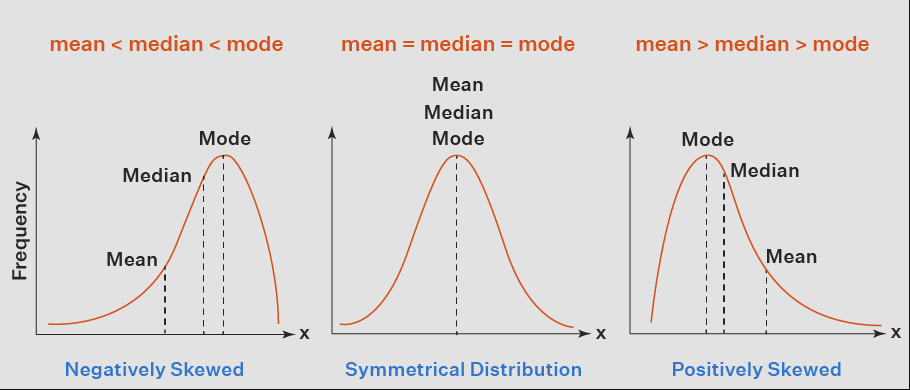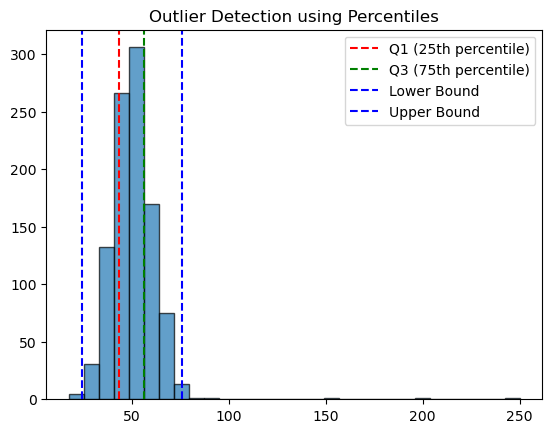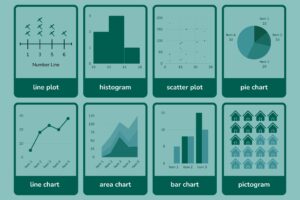Introduction
Statistical measures like percentiles and moments are crucial in understanding data distributions.
- Percentiles describe the relative standing of a data point in a dataset.
- Moments capture various aspects of a distribution such as centrality, spread, skewness, and kurtosis.
These concepts are widely used in descriptive statistics, machine learning, risk analysis, and anomaly detection.
1. Percentiles
Definition
A percentile is a measure that indicates the value below which a given percentage of observations fall. The p-th percentile of a dataset is the value below which p% of the data lies.
Mathematical Formula
For a dataset of size N, the percentile rank of the i-th observation ![]() is given by:
is given by:
![]()
where:
- i is the index of the sorted data,
- N is the total number of observations.
Common Percentiles in Data Science
- 25th percentile (Q1) → First Quartile
- 50th percentile (Q2) → Median
- 75th percentile (Q3) → Third Quartile
- 90th percentile → Often used in performance analysis
- 99th percentile → Detecting anomalies
- IQR (Interquartile Range) -> is a measure of statistical dispersion or spread in a dataset. It represents the range between the first quartile (Q1) and the third quartile (Q3), essentially capturing the middle 50% of the data. i. e IQR=Q3−Q1
Where:
- Q1 (the first quartile) is the median of the lower half of the dataset (25th percentile).
- Q3 (the third quartile) is the median of the upper half of the dataset (75th percentile).
How to calculate it:
- Sort the data in increasing order.
- Find Q1: This is the median of the lower half of the data (the data points below the overall median).
- Find Q3: This is the median of the upper half of the data (the data points above the overall median).
- Calculate the IQR: Subtract Q1 from Q3.
Example in Data Science
- Outlier Detection: Any value beyond the 1.5 × IQR (Interquartile Range) is considered an outlier.
- Machine Learning Model Evaluation: Percentiles help in benchmarking model performance (e.g., latency, error rates).
Python Example of Percentile Calculation
import numpy as np
# Sample data (response times in ms)
data = np.array([10, 20, 22, 30, 35, 40, 50, 55, 60, 100])
# Compute percentiles
percentiles = [25, 50, 75, 90, 99]
values = np.percentile(data, percentiles)
# Display results
for p, v in zip(percentiles, values):
print(f"{p}th percentile: {v}")
#Output
#25th percentile: 24.0
#50th percentile: 37.5
#75th percentile: 53.75
#90th percentile: 63.999999999999986
#99th percentile: 96.4
2. Moments in Statistics
Definition
In statistics, moments are quantitative measures that describe the shape of a probability distribution.
There are four main moments:
- First Moment (Mean) → Measures central tendency
- Second Moment (Variance) → Measures spread
- Third Moment (Skewness) → Measures asymmetry
- Fourth Moment (Kurtosis) → Measures tail heaviness
1st Moment: Mean
The mean \mu is the average of all observations:
![Rendered by QuickLaTeX.com \[ \mu = \frac{1}{N} \sum_{i=1}^{N} X_i \]](https://intellinotebook.com/wp-content/ql-cache/quicklatex.com-5ba5fa5440740f6a903d8bf54079011f_l3.png)
data_mean = np.mean(data)
print(f"Mean: {data_mean}")
2nd Moment: Variance (Spread of Data)
Variance \sigma^2 measures data dispersion:
![Rendered by QuickLaTeX.com \[ \sigma^2 = \frac{1}{N} \sum_{i=1}^{N} (X_i - \mu)^2 \]](https://intellinotebook.com/wp-content/ql-cache/quicklatex.com-b95e9a406e822e6e297d50e659256e60_l3.png)
data_variance = np.var(data)
print(f"Variance: {data_variance}")
3rd Moment: Skewness (Asymmetry of Data Distribution)
Skewness tells whether a distribution is left-skewed (negative), symmetric (zero), or right-skewed (positive).
- Positive Skew: Right tail is longer (e.g., income distribution).
- Negative Skew: Left tail is longer (e.g., exam scores).
![Rendered by QuickLaTeX.com \[ S = \frac{1}{N} \sum_{i=1}^{N} \left( \frac{X_i - \mu}{\sigma} \right)^3 \]](https://intellinotebook.com/wp-content/ql-cache/quicklatex.com-39d740e7da8b5a1f08ecef8c22f69285_l3.png)

from scipy.stats import skew
data_skewness = skew(data)
print(f"Skewness: {data_skewness}")
4th Moment: Kurtosis (Tail Heaviness)
Kurtosis measures whether data has heavy or light tails compared to a normal distribution.
- High Kurtosis (>3): More outliers, heavy tails (e.g., stock market returns).
- Low Kurtosis (<3): Fewer extreme values, light tails (e.g., uniform distribution).
![Rendered by QuickLaTeX.com \[ S = \frac{1}{N} \sum_{i=1}^{N} \left( \frac{X_i - \mu}{\sigma} \right)^4 \]](https://intellinotebook.com/wp-content/ql-cache/quicklatex.com-700cac08eb61667e3443a093d1d38836_l3.png)
from scipy.stats import kurtosis
data_kurtosis = kurtosis(data)
print(f"Kurtosis: {data_kurtosis}")
How Percentiles and Moments Are Used in Data Science?
Feature Engineering:
- Percentiles help normalize data and detect outliers.
- Moments help extract important distribution characteristics for modeling.
Anomaly Detection:
- High kurtosis and extreme percentiles can signal outliers in datasets.
Machine Learning Model Evaluation:
- Percentiles (e.g., 90th percentile latency) measure model efficiency.
- Variance & Skewness help understand dataset imbalance.
Risk Analysis in Finance:
- Percentiles are used in Value at Risk (VaR) models.
- Moments (Kurtosis & Skewness) help assess stock return distributions.
Detecting Outliers Using Percentiles & Moments
import matplotlib.pyplot as plt
# Generate a dataset with outliers
np.random.seed(42)
data = np.random.normal(50, 10, 1000) # Normal distribution
data = np.append(data, [150, 200, 250]) # Adding outliers
# Compute percentiles
Q1, Q3 = np.percentile(data, [25, 75])
IQR = Q3 - Q1
lower_bound = Q1 - 1.5 * IQR
upper_bound = Q3 + 1.5 * IQR
# Detect outliers
outliers = data[(data < lower_bound) | (data > upper_bound)]
print(f"Detected outliers: {outliers}")
# Plot data distribution
plt.hist(data, bins=30, edgecolor='black', alpha=0.7)
plt.axvline(Q1, color='r', linestyle="--", label="Q1 (25th percentile)")
plt.axvline(Q3, color='g', linestyle="--", label="Q3 (75th percentile)")
plt.axvline(lower_bound, color='b', linestyle="--", label="Lower Bound")
plt.axvline(upper_bound, color='b', linestyle="--", label="Upper Bound")
plt.legend()
plt.title("Outlier Detection using Percentiles")
plt.show()





